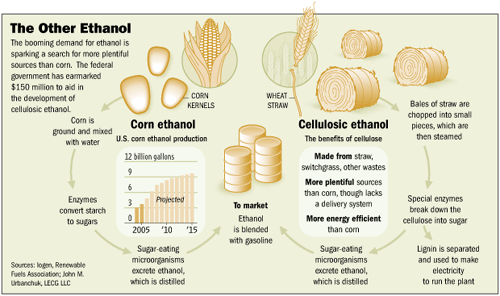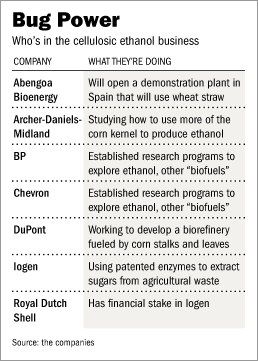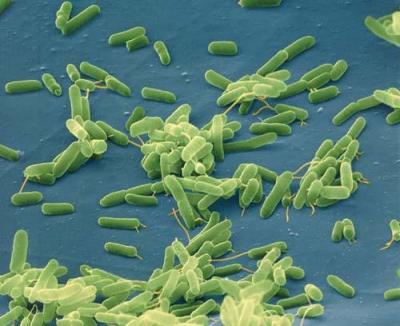Food or fuel. Do we make biofuels out of the food we are going to eat, or do we make fuel to power our cars. Things like biodiesel, ethanol and other biofuels are most often made from things like corn, soy beans, sugar cane, and other food crops. So what is it going to be, do we feed hungry people or hungry cars?
The best choice might turn out to be both. Making ethanol from cellulose might make it possible to make everyone happy. As we talked about a couple days ago, ethanol is most often made by fermenting and distilling alcohol out of anything with sugars in it. Because food crops are full of sugar and carbohydrates (among other tasty qualities), and because we already have the technology to make large quantities of them, they make the perfect feed stock for ethanol production. It also doesn’t hurt that we have a large and powerful farmers lobby in the Midwestern states that can “help” politicians see the wisdom in making farmers (and by farmers I mean giant Agribusiness’s) the next oil tycoons.
“What percentage of our crop output will be needed to supply all of our fuel needs?” you may be asking yourself. Well lets just put it this way, all of it, and then some. There is no way we can supply all of our fuel needs with food crops, if we farmed nothing but ethanol corn and soybeans it still wouldn’t be enough to fuel all the cars and feed all the people. But there is a way to have our bio-fuel and eat it too.

We simply don’t make ethanol out of food, duh. Plants store there energy in easy to eat packets we call fruits, vegetables, tubers, roots, shoots, berries, etc. But they also keep a lot of energy in things we don’t usually call food, things like bark, woody stems, leaves, grass’s, etc. If we could find a way to unlock the sugars and carbohydrates stores in these “waste” parts of the plant we could make ethanol out of it and leave the food for the mouths of hungry people.
This is not a new idea, termites have been using bacteria to break down woody matter for eons. Termites don’t actually eat wood, the symbiotic bacteria that live in their guts eat wood and produce, you guessed it, sugars and carbohydrates that the termite uses as food. Scientists have been finding bacteria, enzymes and other little microbes that break down cellulose (the woody part in plants) and are creating ethanol with them.
“This is the first revelation of how a bacterium chooses from its more than 100 enzymes to break down a particular biomass,†says David H. Wu, professor in the Department of Chemical Engineering at the University of Rochester. “Once we know how a bacterium targets a particular type of biomass, we should be able to boost that process to draw ethanol from biomass far more efficiently that we can today.â€(via)

This industry is heating up. Big players like Dupont and ADM and other large agriculture and scientific firms are getting into the ethanol market. Dupont even claims that using its new bacteria based method is can scientifically demonstrate that it gets more energy out than it puts in, something that has been a big debate in the ethanol world for a long time. Using corn based ethanol, it is still unclear if you use more energy making the corn, harvesting the corn, fermenting the corn, distilling the ethanol, than you would get out of the ethanol when it is burned. Dupont is confident that it has overcome this problem by letting the bacteria do all the work.
A DuPont executive says his company’s cellulosic technology delivers more energy output for energy input than conventional grain ethanol… or even gasoline.
DuPont Biofuels Vice President & General Manager John Ranieri made the comments in a speech today at the World Biofuels Markets conference in Belgium.
Ranieri told the audience that DuPont’s cellulosic process, which it has licensed to Broin, the largest dry-grind ethanol producer in the United States, delivers a higher energy ratio—energy delivered to a customer divided by the energy used to create cellulosic biofuels—is greater than both the energy ratio for grain ethanol and gasoline.(via)
Suprisingly this might not have ever happened had Bush not made is rather fumbling state of the union speech calling for ethanol production. I am a realist when it comes to global warming. I will take any port in the storm, if that means that in the future the historians attribute the ethanol revolution to Bush (even though he has done almost nothing but promote oil, coal, and gas industries for years), well so be it. I am not one to put politics over what is right. And being able to make carbon neutral fuel, while still being able to feed people is the right thing to do.
“Inside the liter-size vessel, a desert-loving bacterium is making motor fuel. The organism, which normally lives on the agave plant of tequila fame, is munching on the chopped-up leaves and stalk of a plant, and excreting a dilute form of ethanol, the gasoline substitute normally made from corn kernels in the U.S.”
…
DuPont’s efforts to research and develop a bio-refinery fueled by corn stover — the stalk and leaves that are left in the field after farmers harvest their crop. The company’s goal is to make ethanol from cellulose as cheaply as from corn kernels by 2009. If it works, the technology could double the amount of ethanol produced by a field of corn.
The technology grew out of a four-year-long research project in which the United States Department of Energy and DuPont have each invested $19 million. The group working with DuPont includes Moline, Ill., farm-equipment maker Deere & Co.; Diversa Corp., a San Diego enzyme provider; Michigan State University; and the National Renewable Energy Laboratories in Golden, Colorado. “The pilot plant envisioned by DuPont executives would cost roughly $50 million to construct and go into operation by 2010,” the article said.
The Wall Street Journal said that advocates for cellulosic ethanol say the task is so daunting that massive government help is needed. Michigan State Prof. Bruce Dale, a leading authority on cellulosic ethanol, argues that the government needs to spend $2 billion in the next few years. Corporate executives want a federal effort akin to the space program. “‘We need something galvanizing,’ says [Tom] Connelly, the DuPont chief scientist.”
“Even though DuPont has deep pockets for experimental work, spending $1.3 billion annually on research and development, company executives say the difficulty of turning biomass into fuel makes it such a risky venture that they probably wouldn’t attempt it without government backing. ‘It’s so challenging that cellulosic ethanol wouldn’t have made the cut,’ says John Ranieri, a DuPont vice president,” it said.
The article noted that DuPont’s big breakthrough so far is genetically modifying an ethanol-producing bacterium — Zymomonas mobilis — so that it is good at eating both the glucose sugar found in the corn kernel and the xylose sugar locked away in cellulose, a crystalline structure that is hard to break apart. Scientists say the trick is akin to getting someone to eat their salad when given the choice of cheesecake.
(via)
Being able to make ethanol from cellulose also opens the possibility of making ethanol from non-food crosp. You could make ethanol from wood waste in the paper and lumber industry, from switchgrass (a fast growing grass that will grow on crop lands not suitable for food crops), even natural prairie grasses (which actually store carbon in the ground making ethanol made from then a carbon NEGATIVE fuel).
If researchers can figure out a way to harness the natural power of these tiny bacteria you may soon be filling up your car on a batch of fuel made from the leftovers of the desk you brought home to set your computer on, or the stalks of the corn you had for lunch, or the holes punched out of three ring binder paper you use for school. All without taking food off of anyone’s table.

Couple of things you might find relevant.
1> The USDA “Billion Tons of Biomass” report, which suggests that there’s about a billion tons of biomass harvestible each year, enough for around 50 – 120 billion gallons of ethanol production annually.
2> The US DOE “Aquatic Species Program” final report that suggests that, actually, it’s a lot cheaper to do this with algae and go to biodiesel.
3> The IEA (International Energy Authority) “Biofuels for Transport: An International Perspective” which suggests that the total planet-wide biofuels potential is about 30% of our current fuel demand.
This is not a contrarian view, and is shared by the chief scientist of BP.
Vinay: I fully agree, the things you point out make me more and more convinced that making ethanol and biodiesel from food is a bad idea and using what we would normally throw away combined with new crops like algae are the way to go. Thanks for the info.
What do you think about the IEA number of 30% total capacity: do you think it’s worth doing all this massive energy economy overhaul – for a net total 30% of the fuel the world needs.
As a for-instance, oil demand rises about 2% per year. As far as I can tell it’s largely due to new drivers in the poorer parts of the world buying new vehicles.
So, by the time the ethanol arrives, odds-are we’re going to be using all of it just to maintain the current status quo.
Compare this, however, to simply moving to diesel engines, and/or hybrids.
Seems like it would make a huge difference without nearly the problems involved of generating all this new ethanol etc. Of course, the rhetoric is that we should do both, but actually, I think we should basically be forcing the economy option and sod the biofuels until algae comes online.
Hi Vinay:
I really don’t think there is any one silver bullet that is going to solve this problem. I think we should be thinking more about silver buckshot. 30% of the worlds fuel needs is a lot. But you make a good point, it would be much easier to switch to electric cars and then power them with solar and wind.
But even if we forced the market to from this day forward sell nothing but electric cars (something that is unlikely to happen) we would still have hundreds of millions of old cars. People are not going to just throw them away, and they are a big reason we have gotten into this mess in the first place.
I see biofuels as a stepping stone to all electric cars. Providing a carbon neutral way to move from oil to sun/wind/small scale hydro/tidal/wave/geothermal/etc.
If that 2% of oil demand each year was instead met with a mix of biofuel/electric cars we could in essence cap our oil usage for transportation as what it is currently. Then we just replace oil burning cars with biofuel and eventually electric cars as fast as we can.
Algae based biofuel will not come online unless there is a market for algae based fuels. Having a lot of biofuel ready cars on the market will spur the development of new sources of biofuel that do not compete with crops, hence algae become a good option.
At least that is how I see things.
Well, the market for fuels from algae is twofold:
1> Diesel vehicles (which can run biodiesel blends up to at least 20% in all cases, and likely up to 100% in most cases.)
2> Ethanol (from the non-oil plant matter)
3> Biobutanol (a heavier alcohol with better – much better – compatibility with gasoline cars.)
The real kicker here is price: biodiesel from algae is expected to come in at around $1.50 a gallon, or somewhere in the region of a $26 / barrel oil price. The motivation here is overwhelming, massive, dollar-a-gallon profit!
I think it’ll happen within 10 years: we’ll see a very rapid move to this kind of fuel economy. We still need great improvements in battery technology to go electric.